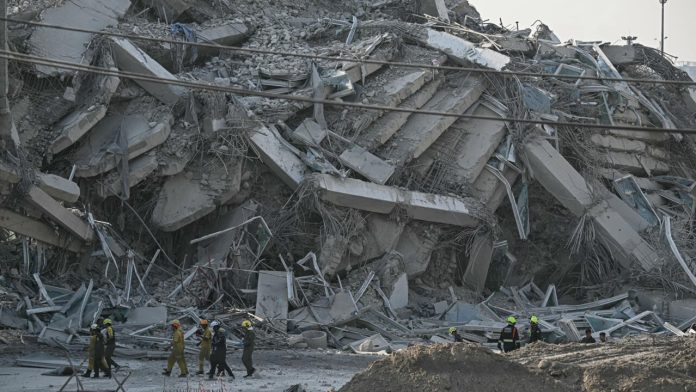The death toll from a 7.7 magnitude earthquake in Myanmar has risen above 1,000. Rescue teams continue to retrieve bodies from collapsed buildings. The earthquake struck near Mandalay, Myanmar’s second-largest city, causing widespread damage.
Myanmar’s military-led government confirmed 1,002 fatalities. It also reported 2,376 injuries and 30 missing people. Officials warn the numbers may continue to rise as more data emerges.
Challenges in relief efforts amid civil conflict
Myanmar is already facing a severe humanitarian crisis due to a prolonged civil war. The conflict complicates rescue operations, making travel across the country dangerous. This raises concerns that the death toll may increase further.
The earthquake hit at midday on Friday, followed by several aftershocks, including one measuring 6.4 in magnitude. The tremors brought down buildings, damaged roads, destroyed bridges, and ruptured a dam.
Impact on neighbouring Thailand
The quake was also felt in Thailand. It shook the greater Bangkok area, home to 17 million people, many living in high-rise buildings.
Bangkok authorities confirmed six deaths, 26 injuries, and 47 missing individuals. Most of the missing were at a construction site near Chatuchak market. A 33-storey high-rise, built by a Chinese firm for the Thai government, collapsed during the quake. A massive dust cloud filled the air as people ran in panic.
On Saturday, heavy machinery was deployed to clear debris. However, hopes of finding survivors were fading. Families and friends anxiously waited for news of their loved ones.
“I was praying they had survived. But when I arrived and saw the destruction, I couldn’t imagine where they could be,” said Naruemol Thonglek, 45. Her partner and five friends from Myanmar were working at the site. “I still pray they are alive.”
Waenphet Panta has not heard from her daughter Kanlayanee since an hour before the quake. “I am praying my daughter is safe, that she survived and is in hospital,” she said.
Myanmar’s vulnerability to earthquake
While earthquakes are rare in Bangkok, they are common in Myanmar. The country lies along the Sagaing Fault, a major north-south fault line.
Seismologist Brian Baptie from the British Geological Survey explained that a 200-kilometre section of the fault ruptured. “A large earthquake in a densely populated area with weak buildings can be devastating,” he said.
Earthquake recovery: Humanitarian response and international aid
Myanmar’s government has urged blood donations in the worst-hit areas. Despite its history of resisting foreign aid, military leader Min Aung Hlaing said Myanmar is open to outside assistance.
The military seized power in February 2021, overthrowing Aung San Suu Kyi’s elected government. It is now fighting both long-established militias and new pro-democracy groups. Large areas remain under opposition control, making some regions inaccessible to aid workers. The United Nations reports that three million people have been displaced, with nearly 20 million in need of aid.
Haider Yaqub, Myanmar country director for NGO Plan International, described the destruction as unprecedented. “Although we are still assessing the full impact, this is one of the worst disasters many of us have ever seen,” he said.
Global assistance efforts
China and Russia, Myanmar’s main arms suppliers, were among the first to provide aid. A 37-member team from China’s Yunnan province arrived in Yangon on Saturday. They brought earthquake detectors, drones, and other equipment, according to China’s Xinhua news agency. Russia sent two planes carrying 120 rescue personnel and emergency supplies.
India has dispatched a search and rescue team along with medical aid. Malaysia plans to send a 50-person team to assist the worst-hit areas. South Korea has pledged $2 million in humanitarian aid. Officials say they will continue monitoring the situation and may offer further support if needed.
The United Nations has allocated $5 million for initial relief efforts. The US government has also pledged support. However, some experts question how effective it will be due to previous reductions in foreign aid budgets.
Authorities warn that assessing the full extent of the devastation may take time. However, with international support, relief efforts are underway to assist those affected.
